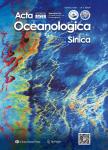Green synthesis of iron oxide(Fe_3O_4)nanoparticles using two selected brown seaweeds:Characterization and application for lead bioremediation
Green synthesis of iron oxide(Fe_3O_4) nanoparticles using two selected brown seaweeds:Characterization and application for lead bioremediation作者机构:National Institute of Oceanography and FisheriesAlexandria 21556Egypt
出 版 物:《Acta Oceanologica Sinica》 (海洋学报(英文版))
年 卷 期:2016年第35卷第8期
页 面:89-98页
核心收录:
学科分类:0710[理学-生物学] 071001[理学-植物学] 07[理学] 0908[农学-水产] 0707[理学-海洋科学]
主 题:seaweeds iron oxide silver nanoparticles
摘 要:The exploitation of different plant materials for the biosynthesis of nanoparticles is considered a green technology because it does not involve any harmful chemicals. In this study, iron oxide nanoparticles(Fe3O4-NPs) were synthesized using a completely green biosynthetic method by reduction of ferric chloride solution using brown seaweed water extracts. The two seaweeds Padina pavonica(Linnaeus) Thivy and Sargassum acinarium(Linnaeus) Setchell 1933 were used in this study. The algae extract was used as a reductant of Fe Cl3 resulting in the phytosynthesis of Fe3O4-NPs. The phytogenic Fe3O4-NPs were characterized by surface plasmon band observed close to 402 nm and 415 nm; the obtained Fe3O4-NPs are in the particle sizes ranged from 10 to 19.5 nm and 21.6 to 27.4 nm for P. pavonica and S. acinarium, respectively. The strong signals of iron were reported in their corresponding EDX spectra. FTIR analyses revealed that sulphated polysaccharides are the main biomolecules in the algae extracts that do dual function of reducing the Fe Cl3 and stabilizing the phytogenic Fe3O4-NPs. The biosynthesized Fe3O4-NPs were entrapped in calcium alginates beads and used in Pb adsorption experiments. The biosynthesized Fe3O4-NPs alginate beads via P. pavonica(Linnaeus) Thivy had high capacity for bioremoval of Pb(91%) while that of S. acinarium(Linnaeus) Setchell 1933 had a capacity of(78%) after 75 min.The values of the process parameters for the maximum Pb removal efficiency by Fe3O4-NPs alginate beads synthesized via P. pavonica(Linnaeus) Thivy were also estimated.



